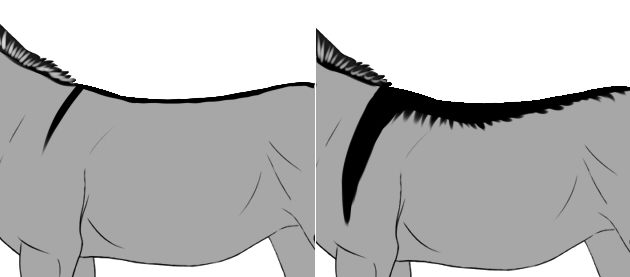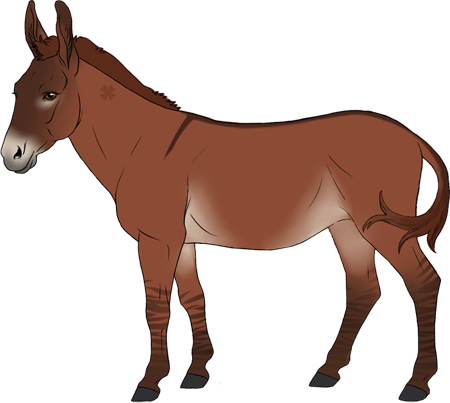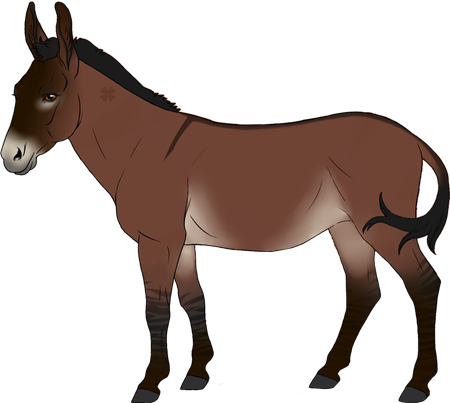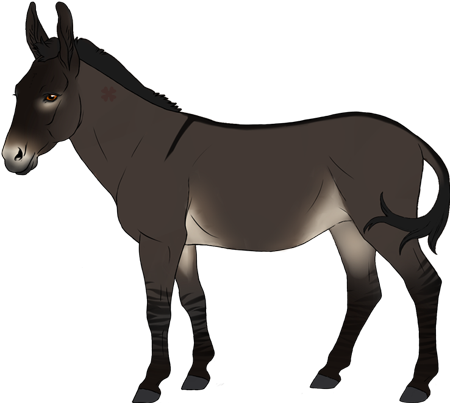Base color modifiers (Agouti)# Bay # Wild Bay/Brown # Seal Bay/Brown |
Dilution modifiers# Dun # Creme # Fungi # Ivorie # Chardonnai # Taffy |
Other modifiers# Points # Flaxen # Sooty |
Dun//Extended Dun
Dun dilutes the base coat to a slightly faded color and causes primitive markings. Dun Drabardis will have dorsal stripes and shoulder crosses. Leg barring may show on their lower legs, either faintly or boldly. Many will also have dark lining on the ear rims. The level of base coat dilution also varies. The dun factor can range from minimal to quite notable depending on the animal. It is not to be confused with Zebardi. The most common type of Extended dun makes the dorsal stripe extra wide, often covering a large section of the donkey's back, with a broad cross going down the shoulder. Extended dun can occur in all dun types. This is sort of a mutation of the DD modifying gene in the Drabardi Donkey breed. Drabardis must have a parent with extended DD to have a chance of inheriting the mutation.
The 'dun factors'
The term "dun factors" refers to; Dorsal stripe: This is a required dun factor marking. If a donkey lacks the dorsal stripe, then it is not a dun. The dorsal stripe is a dark stripe running from the poll to the dock of the tail, along the donkey's spine. Extended duns may have barbs extending off from the main stripe. In extended duns these barbs can reach halfway down the donkey's chest, while normal non-extension duns have dorsal stripe barbs that won't extend far at all (see examples).

A dorsal stripe will always be solid, have crisp edges and be uniformly dark throughout. They can't fade into the body color of the donkey, nor can they be multicolored. The dorsal stripe is unbroken except in the case of a spotted donkey where white can mask over the underlying color of the donkey as well as its other (drabardi) markings. The only thing that can show over spotting is the clover marking.
Cross:This is the dark line that some dun donkeys have running straight from shoulder to shoulder across the withers. The ends of the cross may taper, fade, or be dashed. The extended dun donkey's cross is always broader than on the normal dun.


This is barring or zebra stripes on the legs that goes up to just above the knee/hock. It never covers the entire leg. Not to be mistaken for the Zabardi stripes. If the Drabardi is carrying the Zabardi marking, the dun leg barring will be supressed and replaced with Zabardi stripes. Some dun stripes might just show faintly on the leg like softer 'lacing'.
 Barbs:
Barbs: Some dorsal stripes will have barbs that extend perpendicular to the stripe and head down the rib cage. These are not required, and may vary in length. "Normal" duns have just a few short barbs, while an extended dun can get longer ones that extend down the chest. (See examples above on Dorsal and Cross, as well as below on markings associated with extended dun (6))
Marked Tips:The top half or third of the donkey's ear tips can have the same color as the dorsal stripe. In many cases the donkey also has a slightly fainter marking below the first one that isnt as wide. (See examples below; markings associated with extended dun (1))
Face Mask:A dun mask is darker than the rest of the donkey's body. It covers the front of the donkey's face or just over the bridge of the nose.
Dark Points:The legs are significally darker than the body, but not black (unless the donkey is bay/brown or black) or as dark as the dorsal stripe. (See Leg barring)
Frosting:Frosting in the mane can be subtle or very pronounced. It is a light coloring on the edges of the mane. The "main" part of the mane is darker (even for a flaxen Drabardi), but the hairs that run down the sides of the mane are light. In some cases the frosting can also show on their tail. Look at Fjord horses (where the mane is cut) for more inspiration.

The following are dun markings associated with EXTENDED DUN
Spiderweb:(2) Stripes that resemble a spider's web on the donkeys forehead. If the Drabardi is also carrying the Zabardi marking, the two markings will combine to cover more of the face, fading down to the sides of the jaw.
Chest barring:(3) Barred vertical markings at the front of the chest. If the Drabardi is also carrying the Zabardi marking, the two markings will make the chest barring spread slightly and make the barred markings wider.
Mottling:(4) Mottling appears as dark splotches about the size of peas, or like tiny reverse dapples. The most common place for this marking is the arm/shoulder or gaskin/stifle.
Neck Shadow:(5) Neck shadow is the sooty-looking shading coming down off the top of the neck, just barely going over the shoulders.
Examples of dun
The pictures shown are examples only. Find inspiration on real dun horses.
Grey Dun
Black base coat is diluted into a grey color. Trim and primitive markings are black or dark grey. The base coat can also appear black with a cross (the dorsal/shoulder stripe). In horse terms this color is called 'grullo' or 'grulla'. |
Rose Dun
Red base diluted to a pale reddish color. Trim and primitive markings are a darker shade of red. In horse terms this color is called 'red dun'. |
Bay Dun
Bay base coat generally diluted to a somewhat saturated color similar to red dun but with black trim. |
Wolf Dun
The donkey has a dark chocolatey saturated color with the primitive markings visible. |
| COLORNAME: | Genotype: | Rarity: |
|---|---|---|
| DUN - heterozygous | nD | Common |
| DUN - homozygous | DD | (Very) Common |
| DUN - extended | DD+X | Rare |



